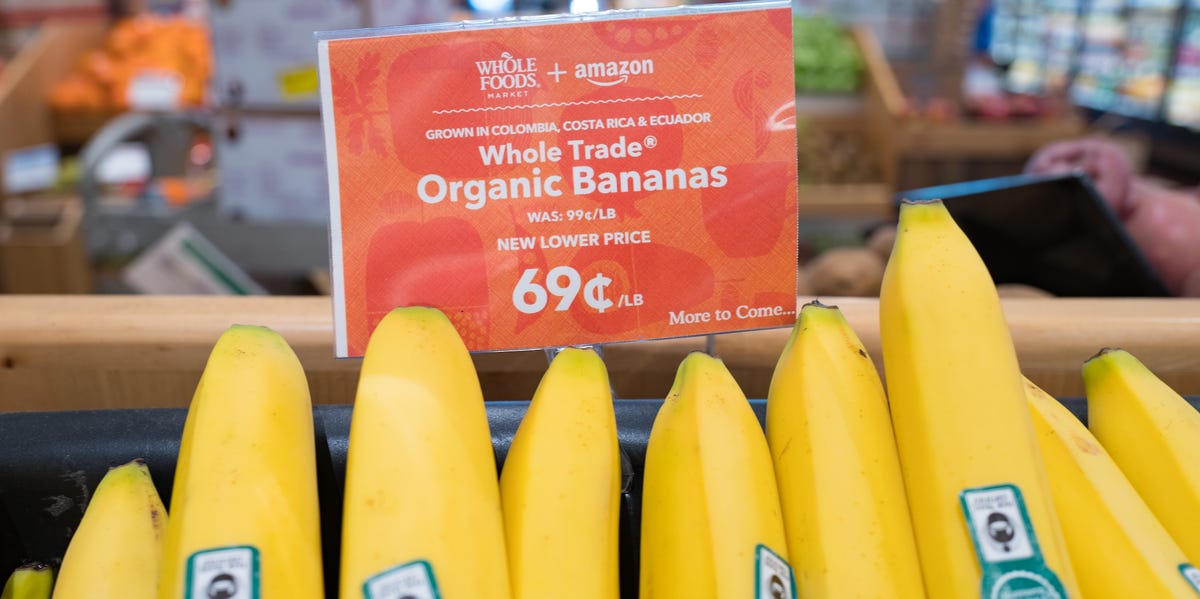- Amazon acquired Whole Foods Market in 2017 for $13.7 billion.
- Before the purchase, Whole Foods had seen declining sales for several quarters.
- Warren Buffett and Albertsons were two other potential buyers who said no to the opportunity.
Amazon acquired Whole Foods Market in 2017 for $13.7 billion after the grocery store chain ran into some financial trouble and sought a buyer.
Whole Foods Market’s founder and CEO John Mackey wrote in his 2020 book “Conscioius Leadership” that the grocery chain had seen declining sales for several quarters before the purchase, and activist investors had planned a takeover.
Mackey felt such a takeover would ruin the Whole Foods brand, so he looked for a buyer. After billionaire Warren Buffet and grocery chain Albertsons declined, he approached Amazon founder Jeff Bezos, who ended up purchasing the company.
The hope was that Amazon would help Whole Foods upgrade its e-commerce business, Mackey wrote.
Amazon and Whole Foods announced a shared goal to “make healthy and organic food affordable for everyone,” Jeff Wilke, CEO of Amazon Worldwide Consumer, said in a 2017 news release about the acquisition.
Amazon promised to lower prices at Whole Foods while maintaining the brand’s commitment to high-quality, natural, and organic food, Wilke said.
In 2022, chief operating officer Jason Buechel took over as CEO of Whole Foods. He’s said he plans to add more Amazon innovations to Whole Foods, including cashier-free Just Walk Out technology and in-store smart shopping carts.
How long has Whole Foods been around?
Whole Foods was founded in Austin, Texas, in 1978 by Mackey and Renee Lawson, and the first store opened two years later, at a time when there were few natural food supermarkets in the U.S., according to the company’s website.
By 1984, the company began expanding beyond Austin and continued to grow. It went public in 1992 at a price of $2.13 a share.
Today, Whole Foods has more than 500 stores in the US, Canada, and the UK, according to the company.
How has the Amazon acquisition changed Whole Foods?
Amazon has centralized much of Whole Foods’ operations at its Austin headquarters and has expanded online ordering and delivery, including opening more “dark stores” to fulfill online orders.
Whole Foods’ private label, 365, also got a new look in 2020, and dozens of new products were added.
What’s the difference between Amazon Fresh and Whole Foods on Amazon?
Amazon Fresh is an online and brick-and-mortar grocery store, featuring everyday products, including brands that most consumers are familiar with. Whole Foods focuses on healthy, organic, and often more expensive products.
Both Amazon Fresh and Whole Foods offer in-store shopping and online ordering for pickup or delivery. Orders can be placed on the Amazon website. There are many more Whole Foods physical locations.
Can you buy Whole Foods on Amazon?
Amazon Prime members can shop Whole Foods at Amazon.com for delivery and free pickup in certain ZIP codes, according to the company.
Can I use my Amazon Prime membership at Whole Foods?
Prime members have access to weekday sales and deals both online and in-store. In Whole Foods stores, shoppers can scan a barcode on their Whole Foods or Amazon apps to access the deals. Additionally, Amazon Prime members can purchase Whole Foods items at Amazon.com for delivery or pickup.
Read the full article here





